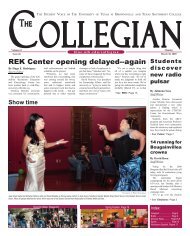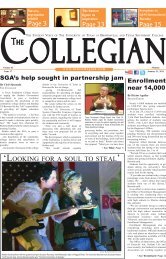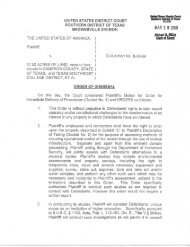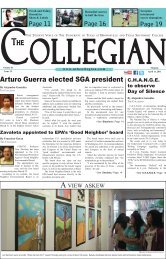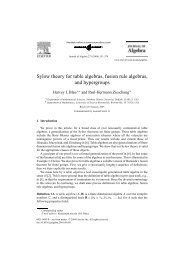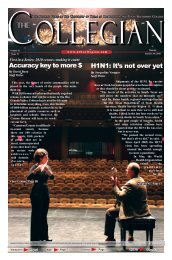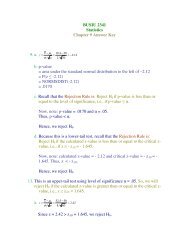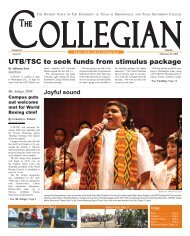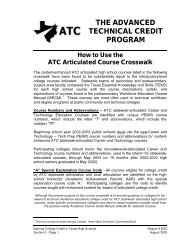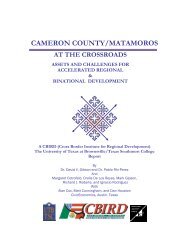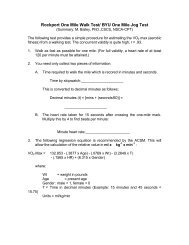Create successful ePaper yourself
Turn your PDF publications into a flip-book with our unique Google optimized e-Paper software.
<strong>ACSM</strong> <strong>Metabolic</strong> <strong>Equations</strong><br />
(HPRED 1410, Dr Bailey, Appendix D, Guidelines)<br />
<strong>ACSM</strong> metabolic equations are typically used for two purposes:<br />
1. To calculate oxygen consumption and from this, the energy expenditure<br />
of a given exercise.<br />
2. To calculate the target workload for a client on the specific mode used.<br />
Note that each equation will have the following components:<br />
VO2 = horizontal component + vertical component + resting component<br />
Walking<br />
Walking: VO2 = H + V + R<br />
Walking: VO2 = 0.1(speed) + 1.8 (speed) (fractional grade) + 3.5<br />
0.1 ml x kg -1 x min -1 = O2 cost of horizontal movement<br />
1.8 ml x kg -1 x min -1 = O2 cost of vertical ascent<br />
Speed = speed in m x min -1<br />
Running<br />
Running: VO2 = H + V + R<br />
Running: VO2 = 0.2 (speed) + 0.9 (speed)(fractional grade) + 3.5<br />
0.2 ml x kg -1 x min -1 = O2 cost of horizontal motion<br />
0.9 ml x kg -1 x min -1 = O2 cost of vertical ascent cost<br />
1
Stepping<br />
Stepping: VO2 = H + V + R<br />
Stepping: VO2 = 0.2 (stepping rate) +1.33 x 1.8 (step height)(step freq) +3.5<br />
= 0.2 (stepping rate) + 2.4 (step height)(step freq) +3.5<br />
1.8 ml x kg -1 x min -1 = O2 cost of vertical ascent<br />
1.33 = O2 cost of stepping down (vertical descent)<br />
(1.33 includes the positive component of stepping up (1.0), and the negative<br />
component of stepping down. (0.3)<br />
step height = step height in meters, step freq = stepping frequency in min -1<br />
Leg and Arm Ergometry<br />
Note that there is no horizontal or vertical component here. All we see is the<br />
resistive component (V) from the ergometer.<br />
Leg Ergometry<br />
Leg Ergometry: VO2 = V (resistive) + R<br />
Note: 1. There is no horizontal component in leg ergometry<br />
2. The vertical component is actually a resistive component.<br />
Leg Ergometry: VO2 = (10.8 x W x M -1 ) + 7<br />
Use (mathematically equivalent); VO2 = 1.8 (work rate)/body mass + 7<br />
1.8 ml x kg -1 x min -1 = cost of cycling against external load<br />
3.5 ml x kg -1 x min -1 = cost of unloaded cycling above and<br />
beyond resting metabolism, so “7” is 3.5 + 3.5.<br />
W = watts, M = mass in Kgs<br />
2
Arm Ergometry<br />
Arm Ergometry: VO2 = V (resistive) + R<br />
Arm Ergometry: VO2 = (18 x W x M -1 ) + 3.5<br />
Use (mathematically equivalent); VO2 = 3 (work rate)/body mass + 3.5<br />
Note: 1. There is no horizontal component in leg ergometry<br />
2. The vertical component is actually a resistive component.<br />
3. In arm ergometry, arm muscle mass is so small that there is<br />
no term for unloaded cyling. Hence, no “7” is seen.<br />
Also needed for arm and leg ergometry:<br />
Power (Kg x m x min -1 ) = (Kg setting)(D)(pedaling cadence in rpm)<br />
D = 6 meters for Monark<br />
= 3 meters for Tunturi<br />
= 2.4 for Monark arm ergometer<br />
Stepwise Approach to <strong>Metabolic</strong> Calculation<br />
1. Conversion to appropriate units and knowledge of common<br />
equivalents.<br />
A. Convert all weights from pounds (lbs) to kilgrams.<br />
* Pounds/2.2 = kilograms<br />
B. Convert speed from miles per hour (m/hr) to meters per minute<br />
(m/min).<br />
* miles/hr x 26.8 = meters/minute<br />
* (also useful; 60/(min/mile) = miles per hour<br />
C. Common equivalents<br />
* (Caloric expenditure in kcals x min -1 )/5 = VO2 in L x min -1<br />
* Liters O2 x 5 kcals/liter O2 = kcals<br />
* 1 pound of fat = 3,500 kcals<br />
* METs x 3.5 m x kg -1 x min -1 = VO2 in ml x kg -1 x min -1<br />
* Gross VO2 in ml x kg -1 x min -1 / 3.5 = METs<br />
* Power in watts x 6 = workload in kg x m x min -1<br />
* (kgm/min)/6 = watts<br />
3
2. Transform VO2 into the most appropriate units.<br />
A. If weight bearing; walking, running, stepping, use ml x kg -1 x min -1<br />
B. If cycling or arm, use ml/min<br />
C. If caloric expenditure needed, convert from ml x kg -1 x min -1 to<br />
liters/minute<br />
3. Choose the proper equation for gross VO2:<br />
Walking: VO2 = 0.1(speed) + 1.8 (speed) (fractional grade) + 3.5<br />
Running: VO2 = 0.2 (speed) + 0.9 (speed)(fractional grade) + 3.5<br />
Stepping: VO2 = 0.2 (step rate) +1.33 x 1.8 (step height)(step rate) +3.5<br />
(step height in meters, where 1 inch =.0254 m)<br />
Leg Ergometry: VO2 = 1.8 (work rate)/body mass + 7<br />
Arm Ergometry VO2 = 3 (work rate)/body mass + 3.5<br />
Power (Kg x m x min -1 ) = (Kg setting)(D)(pedaling cadence in rpm)<br />
Example from <strong>ACSM</strong> Guidelines<br />
1. 30 year old man: He wants to walk at 3.5 mph<br />
* 180 lbs<br />
* RHR of 60<br />
* MHR of 190<br />
* VO2 max 48 ml/kg/min.. You want him at 70 % of his VO2 R<br />
A. What is his minimum training heart rate by the Karvonen method?<br />
THR = (.70)(190 - 60) + 60<br />
THR = 91 + 60 = 151 beats/min<br />
B. What is his target VO2?<br />
VO2R = 48 ml/kg/min – 3.5 ml/kg/min = 44.5 = net VO2<br />
= .70 x 44.5 = 31.2 ml/kg/min<br />
4
C. How steep should the treadmill be if he is walking at his preferred<br />
3.5 mph?<br />
VO2 = 0.1 (speed) + 1.8 (speed)(fractional grade) + 3.5 ml/kg/min<br />
31.2 = 0.1 (93.8) + 1.8 (93.8) (frac grade) + 3.5 ml/kg/min<br />
27.7 = 0.1 (93.8) + 1.8 (93.8)(frac grade)<br />
27.7 = 9.38 + 168.8 (frac grade)<br />
18.3 = 168.8 (frac grade)<br />
fractional grade = 10.8 %<br />
D. What is his target work rate on the Monark bike?<br />
His body mass = 180 lbs/2.2 = 81.8 kg<br />
VO2 = 7.0 +1.8 (work rate)/body mass<br />
VO2 = 7.0 +1.8 (work rate)/81.8<br />
31.2 = 7.0 + 1.8 (work rate)/81.8<br />
24.2 = 1.8 (work rate)/81.8<br />
1980 = 1.8 (work rate)<br />
work rate = 1100 kg x m -1 x min -1<br />
E. If he wants to pedal at 60 rpm on a Monark cycle, what resistance<br />
setting should be used.<br />
Power (Kg x m x min -1 ) = (Kg setting)(D)(pedaling cadence in rpm)<br />
Work rate = (resistance setting)(D)(pedal cadence)<br />
1100 = (resistance setting)(6)(60)<br />
1100 = (resistance setting)360<br />
Resistance setting = 3.05 kg<br />
F. What is the caloric expenditure during 30 minutes of exercise?<br />
Net VO2 = 31.2 ml/kg/min<br />
(VO2 in ml/kg/min)(body mass)/1000 = VO2 L/min<br />
(31.2)(81.8)/1000 = 2.55 L/min<br />
2.55 L/min x 5 = 12.8 kcal/min<br />
12.8 kcal/min x 30 = 383 kcals<br />
5
Text examples, page 311, Guidelines<br />
HPRED 1410, Feb 23, 2004<br />
1. A man weighing 176 lbs runs a pace of 9 minutes per mile outdoors, on<br />
level ground. What is his estimated gross VO2 ?<br />
Conversion to appropriate units and knowledge of common<br />
equivalents.<br />
S = 9 minutes/mile, to convert to m x min -1 ,<br />
1. mph = 60 � min/mile = mph<br />
= 60/9 = 6.66<br />
2. m x min-1 = 6.66 x 26.8 = 178.5<br />
Choose the proper equation for gross VO2: Running:<br />
VO2 = 0.2 (speed) + 0.9 (speed)(fractional grade) + 3.5<br />
VO2 = (0.2 x 178.5 m x min -1 ) + 0 + 3.5<br />
VO2 = 35.7 + 0 + 3.5 = 39.2 ml x kg -1 x min -1<br />
2. To match this exercise intensity (from above) on a Tunturi cycle<br />
ergometer, what setting would you use at a pedal rate of 60 rpm?<br />
Conversion to appropriate units and knowledge of common<br />
equivalents.<br />
176lbs/2.2 = 80 kgs<br />
Choose the proper equation for gross VO2: Leg Ergometry:<br />
VO2 = 1.8 (work rate)/mass + 7<br />
39.2 ml x kg -1 x min -1 = (1.8 x W)/80 + 7<br />
32.2 = 1.8W/80<br />
1431 kg m min = work rate<br />
6
Power (Kg x m x min -1 ) = (Kg setting)(D)(pedaling cadence in rpm)<br />
1431 = Kg (3)(60)<br />
Kg = 7.95<br />
3. If this same man exercised at this intensity 5 times a week for 30<br />
minutes each session, how long would it take him to lose 12 pounds?<br />
(20) p. 311 top<br />
Net VO2 = 39.2 -3.5 = 35.7<br />
Liter of oxygen used =<br />
35.7 ml x kg -1 x min -1 x 80 kg/1000 = 2.856 L/min O2<br />
Kcals used per minute =<br />
2.856 L/min x 5 kcals/Liter O2 = 14.28 kcals<br />
Kcals per session = 14.28 kcals/min x 30 minutes = 428.4 kcals<br />
Kcals/week = 5 times/wk x 428.4 = 2142 kcals/wk<br />
Total Kcals to lose = 12 lbs x 3500 kcals/lb = 42000 kcals<br />
Weeks to lose it = 42000kcals/2142 kcals/week = 19.6 weeks<br />
4. For a desired training intensity of 75 % of the VO2res, at what heart rate<br />
should a 45 year old woman exercise ? Her resting heart rate is 70 beats<br />
a minute.<br />
MHR = 220 - 45 = 175<br />
HRR = 175- 70 = 105<br />
.75 x 105 = 78.75<br />
78.75 + 70 = 149<br />
5. A 198 pound cardiac patient wishes to use an arm ergometer for part of<br />
his rehabilitation program. He works at a power output of 300<br />
kgxmxmin for 15 minutes and then at 450 kgxmxmin for 15 minutes.<br />
What is his average net VO2 (in ml x kg -1 x min -1 ) over this session?<br />
198/2.2 = 90 kgs<br />
7
Arm Ergometry VO2 = 3 (work rate)/body mass + 3.5<br />
First 15 minutes; VO2 = 3 (300)/90 + 3.5<br />
Gross VO2 = 900/90 +3.5 = 13.5 ml x kg -1 x min -1<br />
Net VO2 = 13.5 –3.5 = 10 ml x kg -1 x min -1<br />
15 minutes x 10.0 = 150.0 ml x kg -1 x min -1<br />
Second 15 minutes: VO2 = 3 (work rate)/body mass + 3.5<br />
Gross VO2 = 3(450)/90 + 3.5 = 18.5 ml x kg -1 x min -1<br />
Net VO2 = 18.5 – 3.5 = 15 ml x kg -1 x min -1<br />
15 minutes x 15.0 = 225.0 ml x kg -1 x min -1<br />
Average net= (150 + 225)/30 = 12.5 ml x kg -1 x min -1<br />
6. If an individual reduces his or her dietary intake by 1750 kcal per week,<br />
how much weight (in lbs) would he or she lose in 6 months (26 weeks)?<br />
Weight lost per week = 1750/3500 = .5 pounds<br />
26 x .5 = 13 pounds<br />
7. If an 18 year old girl steps up and down on a 12 inch step at a rate of 20<br />
steps (complete up and down cycles) per minute, what would her gross<br />
VO2 be (in ml x kg -1 x min -1 ) ?<br />
Stepping:<br />
Gross VO2 = 0.2 (step rate) +1.33 x 1.8 (step height)(step rate) +3.5<br />
= 0.2(20) + 1.33 x 1.8 (12)(20) + 3.5<br />
1 inch = 0.0254 meters<br />
step height in meters = 12 x .0254 = .3048<br />
8
VO2 = 0.2(20) + 1.33 x 1.8 (.3048)(20) + 3.5<br />
= 4 + 14.59 + 3.5 = 22.09 ml x kg -1 x min -1<br />
8. A 71-year-old man weighing 180 pounds walks on a motor-driven<br />
treadmill at 3.5 mph and a 15 % grade. What is his gross MET level?<br />
Walking: VO2 = 0.1(speed) + 1.8 (speed) (fractional grade) + 3.5<br />
3.5 mph x 26.8 = 93.8 m/min<br />
VO2 = 0.1(speed) + 1.8 (speed) (fractional grade) + 3.5<br />
= 0.1(93.8) + 1.8(93.8)(.15) + 3.5<br />
= 9.38 + 25.33 + 3.5 = 38.2 ml x kg -1 x min -1<br />
Gross MET level = 38.2/3.5 = 10.9 METs<br />
9
Case Study 1:<br />
Case Studies for HPRED 1410<br />
70 kg man uses 2 liters of oxygen in one minute.<br />
A. How many calories did he burn?<br />
B. What was his exercise in METs?<br />
Case Study 2: A man with the following information will burn how many<br />
kcals each exercise session while running?<br />
Treadmill at 1 % grade<br />
Speed = 6.5 mph<br />
Time = 30 minutes<br />
5 times a week<br />
Body weight = 175 pounds<br />
= 79.5 kg<br />
Case Study 3: If the same man walks for 30 minutes per session, how many<br />
calories per session will he burn?<br />
Treadmill at 4 % grade<br />
Speed = 4.4 mph<br />
Time = 30 minutes<br />
5 times a week<br />
Body weight = 175 pounds<br />
Case Study 4: 38 year old male, resting heart rate = 60, body weight of 170<br />
pounds, percent body fat = 18%<br />
1. Calculate his training heart rate range from 60 to 75 % of the heart rate<br />
reserve.<br />
2. How many weeks would it take him to reduce his body weight to 12 %<br />
body fat if he adhered to a proper program?<br />
10
Case Study 5: A 25 year old woman who weighs 130 pounds has a<br />
predicted VO2 max of 40 ml x kg -1 x min -1 . You decide that you want her to<br />
exercise (run) at 60 % of her VO2 R.<br />
1. How fast should you set the treadmill speed in miles per hour assuming<br />
zero percent grade?<br />
2. If she runs for 40 minutes, 4 days per week, how many calories wills she<br />
burn?<br />
3. At this rate, many weeks would it take her to burn 10 pounds through<br />
this exercise?<br />
Case Study 6: A 24 year old male client tells you that during his last<br />
treadmill run, he measured his heart rate at 145 beats per minute. He tells<br />
you that his resting heart rate is 60. He wants to know “how intense” you, as<br />
an exercise physiologist, think this is.<br />
What percentage of the heart rate reserve (% VO2R ) was he running at?<br />
Case Study 7: You measure a 48 year old man’s VO2 max to be 30 ml x kg -<br />
1 x min –1 . He tells you that he wants to begin shoveling snow from his<br />
driveway from now on for exercise, instead of hiring a local kid. According<br />
to the <strong>ACSM</strong> RM, heavy shoveling is about 9 MET exertion. What would<br />
you advise him?<br />
Your advice:<br />
11
Case Study Solutions for <strong>ACSM</strong> Guidelines Problems<br />
Case Study 1:<br />
70 kg man uses 2 liters of oxygen in one minute.<br />
A. How many calories did he burn?<br />
2 liters x 5 kcals/liter = 10 kcals<br />
B. What was his exercise in METs?<br />
1. 2 liters of oxygen = 2000 millilters of oxygen<br />
2. 2000/70 kg = 28.6 ml/Kg oxygen in one minute<br />
3. MET level = 28.6 ml x kg -1 x min -1 / 3.5 ml/kg/min= 8 METs<br />
4. This is a light jog pace.<br />
Case Study 2: A man with the following information will burn how many<br />
kcals each exercise session while running?<br />
Treadmill at 1 % grade<br />
Speed = 6.5 mph<br />
Time = 30 minutes<br />
5 times a week<br />
Body weight = 175 pounds<br />
= 79.5 kg<br />
Running: Gross VO2 = 0.2 (speed) + 0.9 (speed)(fractional grade) + 3.5<br />
First you need speed in m/min: 6.5 mph x 26.8 = 174.2 m/min<br />
Gross VO2 = 0.2 (174.2) + 0.9 (174.2)(.01) + 3.5<br />
= 34.84 + 1.57 + 3.5 = 39.9 ml x kg -1 x min -1<br />
Net VO2 = 39.9 –3.5 = 36.4 ml x kg -1 x min -1<br />
Liters/minute = (36.4 x 79.5)/1000 = 2.895 Liters/min<br />
2.895 x 5 kcals/liter = 14.5 kcals/minute<br />
12
30 x 14.5 = 434.3 kcals<br />
Case Study 3: If the same man walks for 30 minutes per session, how many<br />
calories per session will he burn?<br />
Treadmill at 4 % grade<br />
Speed = 4.4 mph<br />
Time = 30 minutes<br />
5 times a week<br />
Body weight = 175 pounds<br />
Walking: Gross VO2 = 0.1(speed) + 1.8(speed)(fractional grade) + 3.5<br />
4.4 mph x 26.8 = 117.92 m/min<br />
Gross VO2 = 0.1(117.92) + 1.8(117.92)(.04) + 3.5<br />
11.79 + 8.49 + 3.5 = 23.7 ml x kg -1 x min –1<br />
Net VO2 = 23.7 –3.5 = 20.2 ml x kg -1 x min -1<br />
Liters/minute = (20.2 x 79.5)/1000 = 1.6 Liters/min<br />
1.6 x 5 = 8 kcals/minute, 30 x 8 = 240 kcals<br />
Case Study 4: 38 year old male, resting heart rate = 60, body weight of 170<br />
pounds, percent body fat = 18%<br />
1. Calculate his training heart rate range from 60 to 75 % of the heart rate<br />
reserve.<br />
Minimum THR = (182 - 60) x .60 + 60 = 133.2<br />
Maximum THR = (182 - 60) x .75 + 60 = 151.5<br />
2. How many weeks would it take him to reduce his body weight to 12 %<br />
body fat if he adhered to a proper program?<br />
13
Case Study 5: A 25 year old woman who weighs 130 pounds has a<br />
predicted VO2 max of 40 ml x kg -1 x min -1 . You decide that you want her to<br />
exercise (run) at 60 % of her VO2 R.<br />
1. How fast should you set the treadmill speed in miles per hour assuming<br />
zero percent grade?<br />
VO2 R: 40 ml/kg/min – 3.5 ml/kg/min = 36.5 ml/kg/min<br />
Running: VO2 = 0.2 (speed) + 0.9 (speed)(fractional grade) + 3.5<br />
Target VO2 = .60 x 36.5 ml x kg -1 x min –1 = 24 ml x kg -1 x min –1 .<br />
21.9 = 0.2 (speed) + 0.9 (speed)(0) + 3.5<br />
21.9 = 0.2 (speed) + 3.5<br />
18.4 = 0.2 (speed)<br />
Speed = 92 meters/min<br />
miles/hr x 26.8 = meters/minute<br />
miles/hr x 26.8 = 92 meters/minute<br />
Speed in mph for the treadmill = 92/26.8 = 3.4 mph<br />
(Note: You might find that this client will prefer to walk and need to<br />
recalculate.)<br />
2. If she runs for 40 minutes, 4 days per week, how many calories wills she<br />
burn?<br />
Weight in Kgs = 130/2.2 = 59.1 kgs<br />
Net VO2 = 24 -3.5 = 20.5 ml x kg -1 x min –1<br />
(20.5 ml x kg -1 x min –1 x 59.1)/1000 = 1.211 Liters/O2 per minute<br />
Kcals burned per minute = 1.211 x 5 kcals/liter O2 = 6.06 kcals<br />
Kcals burned per session = 6.06 x 40 minutes = 242.31 kcals<br />
Kcals burned per wk = 242.31 kcals x 4 days/week = 969.2 kcals/week<br />
14
3. At this rate, many weeks would it take her to burn 10 pounds through<br />
this exercise?<br />
10 pounds x 3,500 kcals/pound = 35,000 kcals<br />
35,000/969.2 = 36.1 weeks<br />
Case Study 6: A 24 year old male client tells you that during his last<br />
treadmill run, he measured his heart rate at 145 beats per minute. He tells<br />
you that his resting heart rate is 60. He wants to know “how intense” you, as<br />
an exercise physiologist, thinks this is.<br />
What percentage of the heart rate reserve (% VO2R ) was he running at?<br />
% VO2R = (Exercise HR - Resting HR)/(Max HR - Resting HR)<br />
% HRR = (145 – 60)/(196-60)<br />
= 85/136 = 62.5 % HRR<br />
Case Study 7: You measure a 48 year old man’s VO2 max to be 30 ml x kg -<br />
1 x min –1 . He tells you that he wants to begin shoveling snow from his<br />
driveway from now on for exercise, instead of hiring a local kid. According<br />
to the <strong>ACSM</strong> RM, heavy shoveling is about 9 MET exertion. What would<br />
you advise him?<br />
Functional Capacity = 30/3.5 = 8.57 METs<br />
Your advice:<br />
This would often require supramaximal (above his VO2 max) exertion and he<br />
is 48 years old, at least “moderate risk”. Keep hiring the kid and begin a<br />
light supervised exercise program.<br />
15



